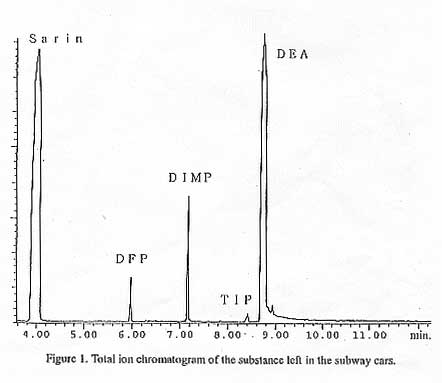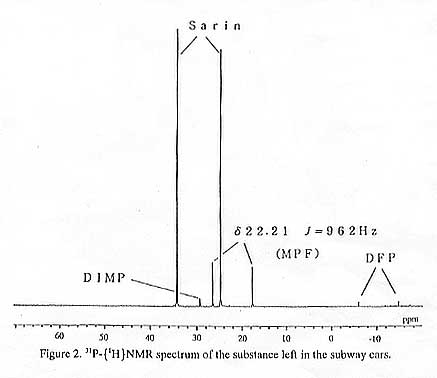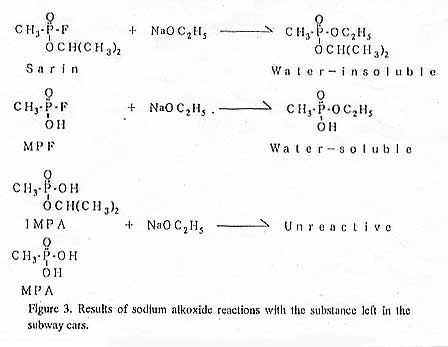「書籍・論文のサリン資料」の概要紹介&三浦評価
|
小川康恭、門倉真人、 縣俊彦、 福本正勝、 佐竹司、 町田勝彦、 0. Sakai、 K. Nakajima、S. Hamaya、 S. Miyazaki、 M. Ohida、 T. Yoshioka、 S. Takagi、 清水英佑(以上東京慈恵会医科大学)、山村行夫(聖マリアンナ医科大学)、安藤皓章、 宮田嘉彦、 H. Nonaka(以上警視庁科学捜査研究所)
|
|
|
重要度
3〜1の3段階で評価/ 数が多いほど重要 重要度は三浦の独断 |
3
|
|
○ 概要 抄録、前文、サリン分析(GC/MS分析、核磁気共鳴法による研究、ナトリウム・エトキシド反応化合物の分析、試料の中身の濃度)、健康への影響(被爆の指標、被害者、アンケート、統計分析、結果、討議)、結論、引用文献という構成になっている。 ○ 以下、対訳で論文の内容を紹介 On the morning of March 20, 1995, the Tokyo subway system was attacked with nerve gas. 1995年3月20日朝、東京地下鉄路線が神経ガスで攻撃された。 According to an announcement from the Tokyo Metropolitan Fire Department, twelve people were killed and 5498 were injured . 東京消防庁の報告によれば、12人が死に、5498人が負傷した。 Checking the hospital patients suffering from the attack, we found that shrinkage of the pupil was a common symptom, and that plasma cholinesterase levels of many patients were under the normal range. 攻撃で被害を受け、病院に行った患者をチェックすると、瞳孔収縮が共通の症状で、多くの患者の血漿コリンエステラーゼ値が正常範囲より低かった。 These symptoms indicated that some kind of organophosphorus substance must be the culprit, and it strongly suggested the use of nerve gas. これらの症状は、なんらかの有機リン化合物が原因に違いないことを示していた。それも神経ガスが使われた、ことを強く示唆した。 This incident reminded us of the Matsumoto 's case, which was thought of as sarin attack executed by a religious cult Aum Shinrikyo in June 27, 1994. この事件は、松本市のことを思い出させた。1994年6月27日宗教カルトのオウム真理教によって実行された松本サリン事件のことを思いおこさせた。 The liquid left in the plastic bags on the subway cars was analyzed, and sarin was detected as a major component. 地下鉄車両のプラスチック袋に残されていた液体を分析すると、サリンが主要な成分として検出された。 There are a few reported incidents of accidental exposure to sarin and a single report on experimental exposure , but there had been no study of mass exposure to sarin until the attack occurred at Matsumoto . サリンに偶然被爆した事故の2、3の報告や、実験的被爆に関する報告が一つあるが、松本事件が起こるまで、サリンの大量被爆についての研究はなかった。 Reports of severe cases, relation between pupil size and acetylcholinesterase(AChE) level , and a survey of subjective symptoms in patients affected by the Tokyo attack have already been reported to journals, but there has not yet been a formal evaluation of the relation between the occurrence of symptoms and dose of exposure to sarin. 高度な症例、瞳孔の大きさとアセチルコリンエステラーゼ値とのあいだの関連の報告、東京事件で被害を受けた患者の自覚症状の概観は、雑誌類ですでに発表されていたが、症状の発生とサリンの被爆量との関連についての正式な評価はまだなかった。 In this study, health effect of victims at acute phase was studied and its relation to the exposure dose was analyzed. この研究では、急性症状を示した被害者の健康影響を調べ、その被爆量との関連を分析した。 Analyzing Sarin サリン分析 Attackers left plastic bags filled with liquid in the subway cars. 犯人は、地下鉄車両に、液体が入ったプラスチック袋を残していった。 Volume of liquid in each bag was about 600 ml and was separated into two layers. それぞれの袋のなかに入った液体の量は、約600ミリリットルで、二層に分かれていた。 The top layer was a transparent liquid of about 200 ml, and the bottom layer was a dark brown liquid measuring about 400 ml. 上層は、透明な約200ミリリットルの液体で、底の層は、約400ミリリットルの暗褐色の液体だった。 A group of Metropolitan Police lead by one of our authors analyzed these materials using GC/MS analysis, NMR, and other methods. 警視庁のグループが、われわれ著者のひとりの手を借りて、これらの試料を、GC/MS分析、核磁気共鳴(NMR)や、そのほかの方法で分析した。 【三浦注】:分析を担当したのが、警視庁科学捜査研究所のメンバーだったことがわかる。GC/MSは、Gas Chromatograph-Mass Spectrometryの略で、ガスクロマトグラフィ・質量分析法と訳している。質量分析法とは、物質の分子をイオン化し、このイオンの質量/電荷を測定して、分子量や構造を知る研究手段である。核磁気共鳴(NMR)について。1H水素、13C炭素、31Pリンなどの奇数個の陽子をもつ原子核は、小さな磁石と考えられ、磁気モーメントを持つ。この小さな磁石をもった物質を磁場の中に入れると、磁気モーメントを持つ核に、回っているこまに起こるような運動が起こる。この運動と同じ周期の電磁波を外部から加えると、電磁波を吸収する。これを核磁気共鳴という。核磁気共鳴スペクトルは、加えた電磁波が吸収され、変化した共鳴信号を測定したものである。 GC/MS Analyses GC/MS分析 The total ion chromatogram of the material left in the subway cars was obtained using temperature programmed methods and capillary column chromatography (Figure 1). 地下鉄車両に残された試料のトータル・イオン・クロマトグラムが、温度プログラムの方法とキャピラリー・カラム・クロマトグラフィを使って得られた。 【三浦注】:キャピラリー・カラムは、毛細管カラムと訳される。長く、径の小さい100m×0.2〜0.5mmの管のこと。  Figure 1, Total ion chromatogram of the substance left in the subway cars. 図1、地下鉄車両に残された物質のトータル・イオン・クロマトグラム。 From retention time analysis and mass spectrum data of standard material of each substance we identified diisopropyl-fluoro-phosphonate (DFP) at a retention time of 6 minutes, diisopropyl-methyl-phosphonate (DIMP) at a retention time of 7.2 minutes, a small peak of triisopropyl-methyl-phosphonate (TIP) at a retention time of 8.2 minutes, and a huge peak of N,N-diethylaniline (DEA) at a retention time of 8.8 minutes. 各物質の基準資料のリテンション・タイム(注4)と質量スペクトルから、リテンション・タイム6分のジイソプロピル・フルオロ・ホスホネート(DFP)、リテンション・タイム7.2分のメチルホスホン酸ジイソプロピル(DIMP)、小さなピークを示したリテンション・タイム8.2分のトリイソププロピル・メチル・ホスホネート(TIP)、巨大なピークが出たリテンション・タイム8.8分のN,N・ジエチルアニリン(DEA)を検出した。 【三浦注】:リテンションタイムは保持時間と訳す。ガスクロマトグラフィで、試料の注入からピークまでの時間をいう。 A peak at 4 minutes retention was suggested to be sarin from the peaks of its fragmented ions in EI-GC/MS (electrical ionization mode) spectrum, from which we could detect demethylated substance of sarin at m/z 125 and methyl-fluoro-phosphonate dihalide at m/z 99, we could not detect the ion of sarin itself which must be at m/z 140. リテンション・タイム4分のピークは、EI-GC/MS(電子イオンモード)スペクトルの断片イオンからサリンと示唆された。そのスペクトルから、サリンからメチルがはずれた125m/zの化合物と、99 m/z)のメチル・フルオロホスホネート・ジハリドという物質を検出したが、サリン分子量のイオンを直接示す140m/zは見つけることはできなかった。 【三浦注】:質量分析法では、化合物に電荷を持たせるため、イオン化という過程が必要となる。EIは多くある方法のうちの一つでもっとも使われている。フィラメントの熱電子が、試料分子の電子1個をたたきだすとイオン化がおこる。電子衝撃法と訳されるが、国際純正・応用化学連合(IUPAC)の命名法では、電子イオン化を用いる。論文では、この表記を使用している。サリンの分子量は140である。サリンのマススペクトルは、99を100とすると、多い順に、99(100)、125(25)、81(20)、43(20)、41(12)、79(10)、42(10)となっている。125は、メチル基CH3(15)がとれた、つまり140から15を引いたピークを示している。99は、科警研の論文では、CH3PF(OH)2と出ている。確かにCH3(15),P(31),F(19),OH(17)×2を足すと、99となる。ところで原文は、methyl-fluorophosphonate dihalideとなっている。dihalideは、2つのハロゲン(F、Cl、Br、I)を意味している。(OH)2なので、ほんとうはmethyl-fluorophosphonate dihydroxideではないのだろうか。それともこちらが勘違いをしているだけなのか。ちなみに、99はサリン、ソマンが持っている。 From CI-GC/MS (chemical ionization mode) we could detect molecular-related ion (M+1) of sarin at m/z 141. CI-GC/MS(化学イオン化モード)からは、サリン分子と関連したイオン(M+1)141m/zを発見した。 【三浦注】:CIは、質量分析法で、試料分子に反応ガスを衝突させ、イオン化する方法。 NMR Studies 核磁気共鳴法による研究 Using 31P−NMR spectrum to detect phosphorus atom signals we received a spectrum as shown in Figure 2. リン原子のシグナルを見つけるためにリン核磁気共鳴スペクトルを使って、図2に示すようなスペクトルを得た。  Figure 2, 31P-{1H}NMR spectrum of the substance left in the subway cars. 図2、地下鉄車両に残された物質のリン水素核磁気共鳴スペクトル。 Signals at -10.42 ppm and 29.32 ppm were identified from their standard materials as DFP and DIMP respectively. -10.42ppmと29.32ppmのシグナルは、基準物質からDFPとDIMPと同定された。 A signal at 29.62 ppm (d, J=1037 Hz) was within the range of the chemical shift of sarin , the signal was at 28.95 ppm (d, JPF=1036 Hz) ; we concluded that this signal was from the phosphorus atom of sarin. 29.62ppm(d,J=1037Hz)のシグナルは、サリンの化学シフト内に入っていた。28.95ppm(d,JPF=1036Hz)のシグナルは、サリンのリン原子からきたものと見なした。 【三浦注】:dはdoubletの略で、スペクトルのピークが二つある二重線を表している。Jは、スピン結合定数(カップリング定数)とよばれている。ピークとピークの間隔を示しており、原子団によってほぼ一定の値を持っている。 These substances identified by NMR studies were comparable with those identified by the GC/MS analyses. 核磁気共鳴研究で同定されたこれらの物質は、GC/MS分析で同定したものと同種だった。 Unfortunately we could not identify the substance from which we received the phosphorus signal at 22.21 ppm (d,J=96.2 Hz). 残念なことに、22.21ppm(d,J=96.2Hz)のリンシグナルを確認することができなかった。 Analysis of Sodium Ethoxide Reaction Products ナトリウム・エトキシド反応化合物の分析 【三浦注】:ナトリウム・エトキシドの分子式は、図3にあるようにC2H5ONa。 Sodium ethoxide was added to the material left in the subway cars and mixed. ナトリウム・エトキシドを、地下鉄車両に残された試料に加え、混合した。 The water soluble portion and ether soluble portion were separated and both portions were treated to induce tenbutyldimethylsiryl (TBDMS) derivatives and analyzed using EI-GC/MS. 水溶性の部分とエーテル溶の部分が分離され、両方の部分はテンブチルジメチルシリル(TBDMS)誘導体にするための処理をされ、EI-GC/MSを使って、分析された。 We could not detect the peak of sarin but could detect the peak of methyl-ethyl-phosphonate isopropyl ester in the mass spectrum analysis of ether soluble portion. サリンのピークは見つけることができなかったが、エーテル溶部分のマス・スペクトルのなかにメチル・エチルホスホネート・イソプロピル・エステルを検出した。 In the spectrum of the water soluble portion we detected TBDMS derivatives of methylphosphonate monoethyl ester, methyiphosphonate (MPA), and isopropyl-methyl-phosphonate (IMPA). 水溶性のスペクトルのなかに、メチルホスホネート・モノエチル・エステル、メチルホスホン酸(MPA)、メチルホスホン酸イソプロピル(IMPA)のTBDMS誘導体を検出した。 The reactions which occurred between the materials and sodium ethoxide can be explained by the mechanism shown in Figure 3. 試料とナトリウム・エトキシドのあいだでおこった反応は、図3で示されるメカニズムで説明できる。  Figure 3, Results of sodium alkoxide reactions with the substance left in the subway cars. 図3、ナトリウム・アルコキシドと地下鉄車両に残された物質との反応の結果。 So called Williamson's synthesis shows that sodium ethoxide reacts with halogens but not with hydroxy residue . いわゆるウィリアムソンのエーテル合成は、ナトリウム・エトキシドが、水酸基ではなく、ハロゲン基と反応することを示している。 Accordingly, sarin was converted to methyl-ethyl-phosphonate isopropyl ester, but MPA and IMPA were not affected and remained intact. したがって、サリンはメチル・エチル・ホスホネート・イソプロピル・エステルに変わり、MPAやIMPAは影響されず、そのまま残った。 【三浦注】:メチル・エチル・ホスホネート・イソプロピル・エステルの示性式は、図3のなかのCH3POOC2H5OCH(CH3)2と思われる。 The important aspect of this reaction was that methylphosphonate monoethyl ester was produced, which means that a content of the material in the bags was methylphosphonate-fluoride (MPF). この反応の重要な側面は、メチルホスホネート・モノエチル・エステルがつくられ、袋の試料の中身がメチルホスホネート・フルオリド(MPF)だったことを意味している。 【三浦注】:メチルホスホネート・モノエチル・エステルの示性式は、図3のCH3POOC2H5OHであろう。なぜメチルホスホネート・モノエチル・エステルとわかったのだろうか。 Considering this result and the structure of MPF, the signal in the 31P-NMR spectrum which we could not identify must have been from MPF. この結果とMPFの構造を考慮すると、同定できなかったリンNMRスペクトル信号はMPFからに違いなかった。 Concentration of the Contents of the Material 試料の中身の濃度 The existence of sarin in the materials left on the subway cars was proved using GC/MS analyses, 31P-NMR studies and other methods. 地下鉄車両に残された試料にサリンがあったことは、GC/MS分析、リン核磁気共鳴法やその他の方法で証明された。 31P-NMR spectra were measured in 1H decoupling mode. リン核磁気共鳴スペクトルは、水素デカップリング法で測定された。 【三浦注】:水素デカップリング法とは、C-H結合のすべての1Hに照射して、多重線のないスペクトルを得る方法。 Sarin and its related chemicals do not have hydrogen atom bound to phosphorous atom directly, and furthermore, the phosphorous atoms were coordinated by four atoms other than hydrogen. サリンや関連化合物は、直接リン原子に結合する水素原子を持たない。さらに、リン原子は、水素ではなく4つの原子と結合している。 This means by stereochemistry that there are no influential hydrogen atoms near the phosphorus atoms. 立体化学では、これはリン原子の近くに影響を及ぼす水素原子がないことを意味している。 【三浦注】:立体化学とは、分子内の立体的原子配列とその性質との関係を論じる化学。 These facts suggests that there is little change in 31P-NMR signals by nuclear Overhauser effect (NOE). これらの事実は、核オーバーハウザー効果(NOE)によるリン核磁気信号に変化がほとんどないことを示している。 【三浦注】:核オーバーハウザー効果とは、2個の陽子が空間的に近い位置にあるとき、一方を照射して飽和させると、他方の陽子のシグナル強度が増大する現象をさす。 Using trimethylphosphonate as an internal standard for the phosphorous contents of the liquid left in the subway car, we analyzed it with 31P-NMR. 地下鉄車両に残された液体のリン量を測定するため、内基準としてトリメチルホスホネートを使い、リン核磁気共鳴法で分析した。 【三浦注】:核磁気共鳴法は、得られたスペクトルを基準物質のピークをもとに、試料のシグナルを測定する方法である。水素核磁気共鳴法では、基準物質としてTMSテトラメチルシランが用いられる。リン核磁気共鳴法では、基準物質としてトリメチルホスホネートを使用することを意味している、と思われる。 Combining these results and the results obtained from the 1H-NMR spectrum, and gas chromatography, the concentrations (w/w) of phosphorous compounds sarin, MPF, DIMP, and DFP were found to be 35%, 10%, 1%, and 0.1%(trace amount) respectively, and those of hexane and DEA, which were used as solvents, or a reaction promoter, were 16% and 37% respectively. これらの結果と水素核磁気スペクトル、ガス・クロマトグラフィから得た結果を組み合わせてみると、リン化合物サリン、MPF、DIMP、DFPの濃度は、それぞれ35%、10%、1%、0.1%(痕跡)であることがわかった。そして、溶剤として、または触媒として使われたヘキサン、DEAが、それぞれ16%、37%であることがわかった。 |
|
|
これは、警視庁科学捜査研究所が、地下鉄サリン事件の原因物質について公開した、はじめての論文と思われる。英文でかかれており、日本語版はみあたらなかった。したがって日本語訳は私がおこなった。 科捜研によれば、地下鉄サリン事件が起きたさい、車両に残されたプラスチック袋のなかに600ミリリットルの液体があり、200ミリリットルの透明な層と400ミリリットルの暗褐色の層に分かれていた。 この中身を分析すると、 37%のジエチルアニリン(反応促進剤)、 35%サリン、 16%ヘキサン(溶剤)、 10%MPF(メチルホスホネート・フルオリド。CH3POFOH)、 1%メチルホスホン酸ジイソプロピル、 0. 1%DFP(ジイソプロピル・フルオロ・ホスホネート。POF[OCH(CH3)2]2) であった、という。 検察側冒頭陳述と同じなのは、当然であろう。 ここでわかるのは、残された袋のなかにまるまる液体が残っていた中身に、以上のものが検出された、ということである。 疑問もないわけではない。 1、 個々のサリン、MPF、 DIMP、 DFP、 ジエチルアニリンのマススペクトルが明らかにされていない。サリンは、一部のマススペクトルの数値のみが記載されているのに、残念である。 2、ヘキサンはどのような方法で検出したのであろうか。 3、検出されたMPF、DFPはどういう役割を果たしているのだろうか。サリンが毒ガス、DIMP(メチルホスホン酸ジイソプロピル)はその副生成物、とわかっているが、MPFやDFPははっきりしない。せっかく分析したのだから、そのへんも触れてほしいものである。 4、検察側冒陳では、サリン、ジエチルアニリン、ヘキサンだけしかあげていない。なぜ、MPF、メチルホスホン酸ジイソプロピル、DFPもあげなかったのだろうか。なにかまずいことでもあるのだろうか。もっともメチルホスホン酸ジイソプロピルは、あとで検出された、と公判に出てきたようだ。 |
|
戻る